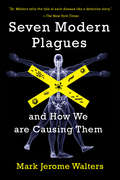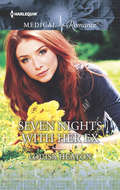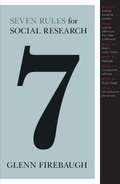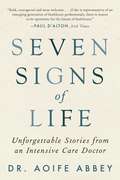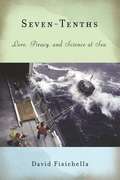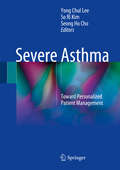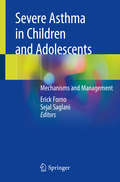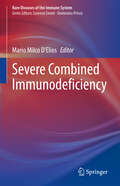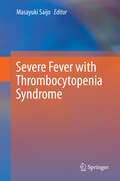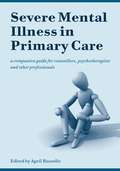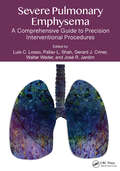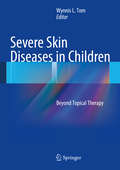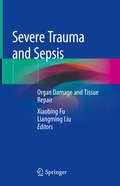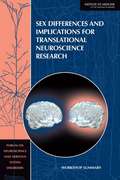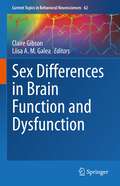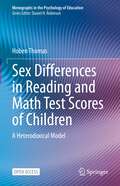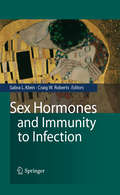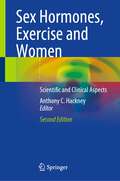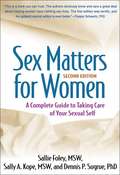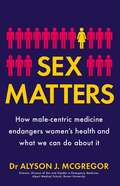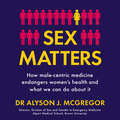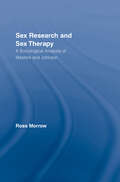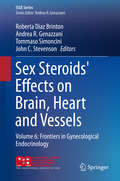- Table View
- List View
Seven Modern Plagues: and How We Are Causing Them
by Mark Jerome WaltersEpidemiologists are braced for the big one: the strain of flu that rivals the pandemic of 1918-1919, which killed at least 20 million people worldwide. In recent years, we have experienced scares with a host of new influenza viruses: bird flu, swine flu, Spanish flu, Hong Kong flu, H5N1, and most recently, H5N7. While these diseases appear to emerge from thin air, in fact, human activity is driving them. And the problem is not just flu, but a series of rapidly evolving and dangerous modern plagues. According to veterinarian and journalist Mark Walters, we are contributing to-if not overtly causing-some of the scariest epidemics of our time. Through human stories and cutting-edge science, Walters explores the origins of seven diseases: mad cow disease, HIV/AIDS, Salmonella DT104, Lyme disease, hantavirus, West Nile, and new strains of flu. He shows that they originate from manipulation of the environment, from emitting carbon and clear-cutting forests to feeding naturally herbivorous cows "recycled animal protein." Since Walters first drew attention to these "ecodemics" in 2003 with the publication of Six Modern Plagues, much has been learned about how they developed. In this new, fully updated edition, the author presents research that precisely pinpoints the origins of HIV, confirms the link between forest fragmentation and increased risk of Lyme disease, and expands knowledge of the ecology of West Nile virus. He also explores developments in emerging diseases, including a new chapter on flu, examining the first influenza pandemic since the Hong Kong flu of 1968; a new tick-borne infection in the Mid-West; a second novel bird flu in China; and yet a new SARS-like virus in the Middle East. Readers will not only learn how these diseases emerged but the conditions that make future pandemics more likely. This knowledge is critical in order to prevent the next modern plague.
Seven Nights with Her Ex
by Louisa HeatonOne week to win her back! For neurologist Beau Judd, a medical survival course in Yellowstone Park is her chance to experience something completely different. But her trip halfway around the world only brings her closer to her past-the man who left her at the altar! Twelve years ago Dr. Gray McGregor made the most difficult decision of his life. Now, brought back together with Beau as they head into the wild, he realizes what a mistake it was. Can he win back the woman he loves in just seven days?
Seven Rules for Social Research
by Glenn FirebaughSeven Rules for Social Research teaches social scientists how to get the most out of their technical skills and tools, providing a resource that fully describes the strategies and concepts no researcher or student of human behavior can do without. Glenn Firebaugh provides indispensable practical guidance for anyone doing research in the social and health sciences today, whether they are undergraduate or graduate students embarking on their first major research projects or seasoned professionals seeking to incorporate new methods into their research. The rules are the basis for discussions of a broad range of issues, from choosing a research question to inferring causal relationships, and are illustrated with applications and case studies from sociology, economics, political science, and related fields. Though geared toward quantitative methods, the rules also work for qualitative research. Seven Rules for Social Research is ideal for students and researchers who want to take their technical skills to new levels of precision and insight, and for instructors who want a textbook for a second methods course. The Seven Rules There should be the possibility of surprise in social research Look for differences that make a difference, and report them. Build reality checks into your research. Replicate where possible. Compare like with like. Use panel data to study individual change and repeated cross-section data to study social change. Let method be the servant, not the master.
Seven Scents: Healing and the Aromatic Imagination
by Dorothy P. Abram Laura MernoffIdentifying seven aromatic plants with specific psychoactive properties, the author describes the different states of consciousness that are achieved, manipulated, and transformed by the people and cultures that use them in specialized ways, both in the past and in the contemporary world. Focusing on the role that scent plays in healing and spiritual experience, the author explores the use of the fragrant tulsi plant both in Hindu women's ritual and to treat mental and physical ailments. She analyses the appearance of the lotus in sacred Egyptian customs, and as a model of the process of psychological change through metaphorical journeys, as witnessed in shamanic practice and its relation to the Biblical book of Job. Making a significant contribution to the understanding of the healing state, the book is stimulating reading for all those who work with and are interested in aromatics, the sense of smell, or the nature of spiritual experience.
Seven Signs of Life: Unforgettable Stories from an Intensive Care Doctor
by Dr. Aoife AbbeyFor Readers of Paul Kalanithi’s When Breath Becomes Air, an Intensive Care Doctor Reveals How Everyday Emotions Are Taken to Extremes in the ICU Dr. Aoife Abbey takes us beyond the medical perspective to see the humanity at work inside our hospitals through the eyes of doctors and nurses as they witness and experience the full spectrum of human emotion with every shift. It is their responsibility to mitigate the grief of a family in mourning, calm a patient about to die, and confront their own fear of failure when lives are on the line. Whether they're providing hospice care, tending to victims of car accidents or violent attacks, determining the correct treatment for someone displaying signs of a heart-attack or stroke, and managing staff, stress is a doctor's number one companion. Cycling through the whirlwind of emotion that accompanies every case isn’t only exhausting—it can be fatal. Told throughseven key emotions—fear, grief, joy, distraction, anger, disgust, and hope—Seven Signs of Life opens the door, and heart, of the hectic life inside a hospital to reveal what it means to be alive and how it feels to care for others.
Seven-tenths: Love, Piracy, and Science at Sea
by David FisichellaA disillusioned man and a blind oceanographer find love and adventure while studying the world's oceans.
Seventh Daughter: An Enchanting Medical Romance (Medical Romances #14)
by Gill SandersonAnother heartwarming medical romance from best-selling author Gill Sanderson! Perfect for fans of Mia Faye, Laura Scott, Helen Scott Taylor, Grey's Anatomy and ER.Readers love Gill's gripping medical romances!'This book is just what you need, a light medical romance novel that you will definitely enjoy' 5* reader review'This writer has the gift to encapture you... Once you pick up this book you'll be truly spellbound' 5* reader review'I loved this story... Good job Gill Sanderson' 5* reader reviewShe had a gift that not everyone understood...Dr Delyth Price was stunned by her reaction to her new boss, the intriguing Dr James Owen. He was everything she'd ever wanted in a man. But Delyth was the seventh daughter of a seventh daughter and had a gift that not everyone understood. James, at least, seemed prepared to listen, if not to believe ... and he asked her out, even if he was clearly holding something back.Then she discovered his light-hearted side, and fell even more deeply in love.Don't miss Gill Sanderson's enthralling medical romances, including the A Lakeland Practice and the Good, Bad and Ugly series.
Severe Asthma
by Yong Chul Lee So Ri Kim Seong Ho ChoThis book presents state of the art knowledge on severe asthma with the aim of providing readers with a clear understanding of, first, the heterogeneity of the condition and of patients' symptom profiles and responses to therapy and, second, the future implications of this heterogeneity for individualized patient care. After an opening section that offers an overview of severe asthma, including its clinical significance, the pathogenesis, available diagnostic approaches, and treatment options are described in detail. The sections on diagnosis and treatment cover the role of biomarkers, the use of radiologic diagnostic modalities, and both pharmacologic and non-pharmacologic therapies, including emerging options that will address hitherto unmet needs of patients. The outcomes of cutting-edge preclinical and clinical research are carefully documented and numerous useful tips provided on patient management. The inclusion of many informative schematic figures will assist readers in grasping the contents easily. The book will be of high value for medical students, researchers, general physicians, specialists, and paramedical staff.
Severe Asthma in Children and Adolescents: Mechanisms and Management
by Erick Forno Sejal SaglaniThis book provides readers with a comprehensive review of severe asthma in children and adolescents, covering epidemiology, genetics, risk factors, co-morbidities, clinical presentation, diagnosis and treatment. Written by leaders in the field, chapter discussions draw on the mechanisms driving the disease, genetics, multidisciplinary approaches, immunomodulators, and other important aspects in the management of the disease. Severe Asthma in Children and Adolescents: Mechanisms and Management is designed to be a practical guide, opening with an introduction on the epidemiology of severe childhood asthma, as well as a discussion of special considerations of the disease unique to the preschool-aged patient. The distinctions between the diagnosis and management of asthma in young children of various ages, and specific approaches for the adolescent with severe asthma, including the transition into adult care are then addressed. Finally, the book closes with a discussion on the current state and future avenues for severe asthma research. Severe Asthma in Children and Adolescents is an indispensable reference for the healthcare professional, for basic and translational researchers, as well as for students, residents and fellows.
Severe Combined Immunodeficiency (Rare Diseases of the Immune System)
by Mario Milco D’EliosThis handy volume, that can also serve as an integration to the preceding work Cellular Primary Immunodeficiencies by the same editor, presents detailed state of the art knowledge on Severe Combined Immunodeficiency (SCID) with extensive coverage of both basic science discoveries and the latest clinical advances in the field. The book is structured according to the most recent classifications including update on the immunological synapse, as well as on bioinformatics in primary immunodeficiencies leading the reader towards the computational immunology era. Readers will also find in-depth descriptions of SCID genes and related clinical application, and aspects such as differential diagnosis, clinical management, and the role of vaccines are also addressed. The authors are recognized experts world-wide and have crafted their chapters to turn Severe Combined Immunodeficiency in a valued, compact update for immunologists, paediatricians, internists, rheumatologists, and infectious diseases specialists, that MDs and PhD students will find informative as well.
Severe Fever with Thrombocytopenia Syndrome
by Masayuki SaijoThis book presents the latest knowledge on all aspects of severe fever with thrombocytopenia syndrome (SFTS), an emerging infectious disease endemic to China, South Korea, and Japan that is caused by a bunyavirus first discovered in 2011, widely referred to as SFTS virus (SFTSV) though recently renamed Huaiyangshan banyangvirus. The contents will be of interest for the light that they cast on not only this viral infection but viral hemorrhagic fevers in general. The opening chapters summarize general considerations and perspectives regarding SFTS and describe the discovery process in each of the affected countries. The basic mechanism of SFTSV infection is then examined from the perspectives of epidemiology, pathology, and virology. The book goes on to examine in detail the mode of spread and transmission of SFTSV, means of infection control, and diagnosis and therapy. The final two chapters explore Heartland virus infections and Crimean-Congo hemorrhagic fever with the aim of highlighting similarities and differences compared with SFTS. This book will be of interest to all researchers who study emerging viruses and infections, whether in Asia or elsewhere, as well as to clinicians who may encounter SFTS.
Severe Mental Illness in Primary Care: A Companion Guide for Counsellors, Psychotherapists and Other Professionals
by April RusselloThere is increasing development and use of care pathways and a growing demand for guidance and advice on how to develop them. This practical guide meets this demand. It reflects the latest experience and incorporates best practice with contributions from highly experienced members of the National Pathways Association. It links well with the coming National Service Frameworks and National Institute of Clinical Excellence guidance. Case studies legal questions and common difficulties are all included and examined. Developing Care Pathways is in two parts: the handbook which defines and describes pathways and the roles of healthcare professionals involved with them and the tool kit which provides a detailed step-by-step guide to developing a care pathway. This work is essential reading for managers and clinicians in organisations developing care pathways throughout secondary and primary care.
Severe Pulmonary Emphysema: A Comprehensive Guide to Precision Interventional Procedures
by Luis C. Losso, Pallav L. Shah, Gerard J. Criner, Walter Weder, and José R. JardimChronic obstructive pulmonary disease is, of 2024, one of the three main causes of death in the world, affecting around 12% of the world's population. Its incidence is estimated to increase in the coming decades due to continuous exposure to risk factors and to an aging population.Pulmonary emphysema is one of its most serious phenotypes, with chronic and inexorable progression and, in the most severe stages, it is highly disabling and lethal.This book reviews knowledge about the pathophysiology of severe pulmonary emphysema and the current innovative interventional and minimally invasive therapeutic concepts for the management of these advanced stages of emphysema, based on the best scientific evidence.This guide provides to multidisciplinary pulmonary boards of experts in advanced lung diseases, current criteria for the choice of precision therapeutic options and beyond to maintaining optimized medical treatment to controlling lung hyperinflation, and alleviating patients' symptoms.This book is a valuable resource for clinicians dealing with critically ill patients with COPD.
Severe Skin Diseases in Children
by Wynnis L. TomA textbook to guide practitioners on treating severe skin diseases in children, when they have failed topical therapy-- will discuss the appropriate candidates, considerations and approaches in drug therapy, possible problems that may arise. Photographs will help to illustrate the cases/conditions.
Severe Trauma and Sepsis: Organ Damage and Tissue Repair
by Xiaobing Fu Liangming LiuThis book discusses recent progress in organ damage and tissue repair following severe trauma and sepsis. In part 1, it introduces the theory and clinical practice in organ damage. In part 2, it covers all the subjects of sepsis, ranging from mechanism, inflammation, and infection to the lung injury and neonatal sepsis. In part 3, it discusses 4 new advances techniques in tissue repair. There are 20 chapters contributed by experts in each area.This book is a valuable reference for scientists and clinicians to know the new knowledge and technology in severe trauma and sepsis, which will benefit their work in research and clinic through multidisciplinary collaboration.
Sex Differences and Implications for Translational Neuroscience Research: Workshop Summary
by Institute of Medicine of the National AcademiesBiological differences between the sexes influence not only individual health but also public health, biomedical research, and health care. The Institute of Medicine held a workshop March 8-9, 2010, to discuss sex differences and their implications for translational neuroscience research, which bridges the gap between scientific discovery and application.
Sex Differences in Brain Function and Dysfunction (Current Topics in Behavioral Neurosciences #62)
by Claire Gibson Liisa A. M. GaleaDoes sex matter when it comes to brain function? This volume attempts to answer this very important question which is of relevance to the disciplines of psychology, neuroscience, psychiatry and neurology. Understanding how brain function and resultant behaviors may differ between the sexes impacts upon our knowledge of the pathology and development of treatments for various neurological and psychiatric disorders, particularly those that show significant sex differences in either prevalence and/or manifestation of symptoms. This volume covers three main themes of research into sex differences in basic neurobiology, psychology, preclinical research and clinical research. It begins by exploring our understanding of sex and gender in relation to both animal and human behaviors and discusses the relevance, and importance, of considering sex and gender when conducting research into brain function and behaviors. The second theme focuses on how sex and gender influence mental health and considers the impact of our immune system and the changes that occur with ageing. Finally, the third aspect focuses on examples of neurological disorder which show sex differences in terms of their aetiology and/or symptomology and considers the relevance in the development of treatment for these disorders including dementia, stroke and multiple sclerosis. This volume is of considerable interest to mental health and neurology professionals, including psychiatrists, neurologists, nurses, allied health clinicians and pharmacists. It is also helpful and important for preclinical researchers working in neuroscience, psychopharmacology and reproductive endocrinology.
Sex Differences in Reading and Math Test Scores of Children: A Heterodoxical Model (Monographs in the Psychology of Education)
by Hoben ThomasThis open access book examines why reading and math test scores for boys and girls have differed since the origins of testing in the United States. It details the pattern of differences that have remained largely unchanged for more than 100 years in the United States and worldwide. The book explores why boys have modestly larger math test score means than girls, and why girls have far larger reading test score means than boys. Boys have larger test score variances for both tasks. The only data of focus—and thus the only data to be explained—are boys’ and girls’ test score sample means and variances. In addition, the book provides the only coherent theory of gender differences explaining math and reading test score means and variances obtained in observational settings. It develops the simple genetical idea framed within a finite probability mixture model; it provides parameter estimates and displays numerous estimated probability distributions associated with the selected accessible studies chosen for analysis; and it extends the theory and provides explanations for never understood puzzling features of test score data. The book requires no auxiliary sources, although some understanding of random variables and probability theory is required to follow the formalization. It contains all technical details, including the estimation procedure and an R code implementation. Key areas of coverage include: · Extensive literature summary from a unique data inequalities perspective. · Perspective that challenges existing viewpoints on sex differences, falsifying conventional perspectives. · Illustrates probability modeling of psychological data. · Illustrates the failure of conventional statistics to explain data and the need for modeling data. Sex Differences in Reading and Math Test Scores of Children is an invaluable resource for researchers, professors, and graduate students in educational psychology, teaching and teacher education, literacy / language teaching and learning, mathematics education, curriculum studies, developmental psychology, statistics, and all interrelated disciplines.
Sex Hormones and Immunity to Infection
by Craig Roberts Sabra L. KleinWhy sex matters Among human and nonhuman animals, the prevalence and intensity of infection typically is higher in males than females and may reflect differences in exposure as well as susceptibility to pathogens. Elevated immunity among females is a double-edged sword in which it is beneficial against infectious diseases but is detrimental in terms of increased development of autoimmune diseases. The present book critically reviews the evolutionary origin and the functional mechanisms responsible for sexual dimorphism in response to infection. It emphasizes the value of examining responses in both males and females to improve our understanding about host-pathogen interactions in both sexes. The contributors are experts in their specific disciplines which range from microbiology and immunology to genetics, pathology, and evolutionary biology. The book aims at bringing insight to the treatment and management of infectious diseases; it delineates areas where knowledge is lacking and highlights future avenues of research.
Sex Hormones, Exercise and Women: Scientific and Clinical Aspects
by Anthony C. HackneyNow in a revised and expanded second edition including seven brand new chapters, this book compiles and synthesizes the latest research and clinical evidence regarding the intricate relationship between sex hormones and the physical activity level and overall health of the female endocrine system across the lifespan. Expert authors from around the world discuss in detail the impact of sex hormones on energy metabolism, cardiorespiratory system, nervous system, and musculoskeletal health, as well as environmental and psychological factors affecting exercise and sexual health. Considerations of the hormonal and physiological changes to the menstrual cycle and in menopause due to exercise receive chapters of their own. New to this edition are discussions of pregnancy, menopause, aerobic endurance training, the transgender athlete, sports performance, and the future of sports and exercise science relating to the active female. Covering a hot topic in sports medicine and science, Sex Hormones, Exercise and Women, Second Edition will be of interest to researchers, clinicians, exercise scientists, and residents and fellows in these areas.
Sex Matters for Women, Second Edition
by Sally A. Kope Sallie FoleySex is talked about more openly today than ever before, but if you still struggle with sexual myths, self-doubt, and "embarrassing" questions, you're in good company. Now in a fully updated second edition, this trusted guide has already helped many thousands of women understand how their bodies work and take charge of their sexuality. The authors are experienced therapists who interweave candid reflections from diverse women with current, science-based information, exercises, and advice. You'll find answers to everything from how to have more satisfying sex to questions about body image, anatomy, hormones, relationships, sexual orientation, sexually transmitted infections, and trauma. Sexuality is a lifelong journey--this book gives you a roadmap for self-discovery and growth.
Sex Matters: How male-centric medicine endangers women's health and what we can do about it
by Dr Alyson McGregor'McGregor is kickass; a respected crusader. If you're a woman, she's definitely the doctor you'd want to see in an emergency or to install as head of medical education' The TimesA clarion call about the dangers of medicine for women, as well as a manual for how women can get the right care for their bodies.Sex Matters tackles one of the most urgent, yet unspoken issues facing women's health care today: all models of medical research and practice are based on male-centric models that ignore the unique biological and emotional differences between men and women - an omission that endangers women's lives. The facts surrounding how male-centric medicine impacts women's health every day are chilling: in the ER, women are more likely to receive a psychiatric diagnosis with regard to opioid use, while men are more likely to be referred for detoxification; the more vocal women become about their pain, the more likely their providers are to prescribe either inadequate or inappropriate pain relief medication; women often present with nontraditional symptoms of stroke, which causes delays in recognition by both them and their health professionals; and a government accountability study found that 80% of drugs that are withdrawn from the market are due to side effects that happen to women (a result of testing drugs mostly on men).Leading expert on sex and gender medicine Dr Alyson McGregor focuses on the key areas where these differences are most potentially harmful, addressing:· Cardiac and stroke diagnosis and treatment in women; · Prescription and dosing of pharmaceuticals;· Subjective evaluation of women's symptoms; · Pain and pain management;· Hormones and female biochemistry (including prescribed hormones); · How economic status, race, and gender identity are additional critical factors.Not only does Dr McGregor explore these disparities in depth, she shares clear, practical suggestions for what we can do. A work of riveting expose, revelatory insights into the medical establishment and actionable guidance for putting this information to use, Sex Matters is an empowering roadmap for reinventing modern medicine - and for self-care.
Sex Matters: How male-centric medicine endangers women's health and what we can do about it
by Dr Alyson McGregorA clarion call about the dangers of medicine for women, as well as a manual for how women can get the right care for their bodies.Sex Matters tackles one of the most urgent, yet unspoken issues facing women's health care today: all models of medical research and practice are based on male-centric models that ignore the unique biological and emotional differences between men and women - an omission that endangers women's lives. The facts surrounding how male-centric medicine impacts women's health every day are chilling: in the ER, women are more likely to receive a psychiatric diagnosis with regard to opioid use, while men are more likely to be referred for detoxification; the more vocal women become about their pain, the more likely their providers are to prescribe either inadequate or inappropriate pain relief medication; women often present with nontraditional symptoms of stroke, which causes delays in recognition by both them and their health professionals; and a government accountability study found that 80% of drugs that are withdrawn from the market are due to side effects that happen to women (a result of testing drugs mostly on men).Leading expert on sex and gender medicine Dr Alyson McGregor focuses on the key areas where these differences are most potentially harmful, addressing:· Cardiac and stroke diagnosis and treatment in women; · Prescription and dosing of pharmaceuticals;· Subjective evaluation of women's symptoms; · Pain and pain management;· Hormones and female biochemistry (including prescribed hormones); · How economic status, race, and gender identity are additional critical factors.Not only does Dr McGregor explore these disparities in depth, she shares clear, practical suggestions for what we can do. A work of riveting expose, revelatory insights into the medical establishment and actionable guidance for putting this information to use, Sex Matters is an empowering roadmap for reinventing modern medicine - and for self-care.(P)2020 Hachette Audio
Sex Research and Sex Therapy: A Sociological Analysis of Masters and Johnson (Routledge Advances in Sociology #Vol. 32)
by Ross MorrowGynaecologist William Howell Masters and psychologist Virginia Eshelman Johnson pioneered research into the nature of human sexual response and the diagnosis and treatment of sexual disorders and dysfunctions from 1957 until the 1990s. This book examines their influential scientific sex research and its groundbreaking implications for sex therapy and the study of human sexuality. Until now, these developments have been largely ignored in sociology. The book illuminates how Masters and Johnson have constructed their apparently scientific ideas about sexual function and dysfunction with reference to dominant Western discourses about sexuality. In addition, the book will explore some of the wider theoretical, conceptual and historical issues relating to the study of human sexuality. These will include a critical evaluation of conventional accounts of the history of the sociology of sex, particularly in the United States, major theoretical frameworks used in the study and understanding of human sexuality, and some of the key concepts underpinning sex research and sex therapy.
Sex Steroids' Effects on Brain, Heart and Vessels: Volume 6: Frontiers in Gynecological Endocrinology (ISGE Series)
by Roberta Diaz Brinton Andrea R. Genazzani Tommaso Simoncini John C. StevensonThis book analyzes the effects of estrogens and progesterone on brain cells, the immune system, neuro inflammation, myelin formation and steroid receptor distribution, as well as their clinical impacts. It also explores the relationship between sex-steroid withdrawal and the development of brain symptoms such as hot flushes, sleep disorders, mood changes, depression and also cognitive disorders and dementia, as well as the effects of hormone menopause therapy on such symptoms and diseases. Starting with obstetrical history and cardiovascular risk in later life, the second part of the book examines the effects of estrogens and progestogens on vascular tissues, atherosclerosis and coronary heart diseases, as well as the impact of hormone replacement therapies on cardiovascular risks and mortality. This volume is a useful, clear and up-to-date tool for gynecologists, endocrinologists, neurologists and cardiologists, and serves as a valuable source of information for all physicians involved in women’s health.
